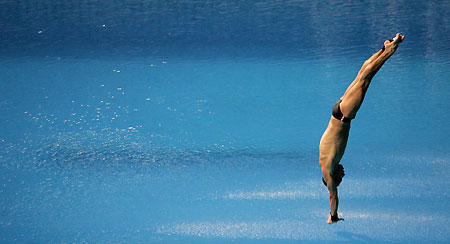 Olympic Sport since 1924
Olympic Sport since 1924
Almost a century ago, "fancy diving" entered the Olympic Games as a new
event. It was simply diving, as we know it today, and indeed, the 1996 programme
did not change a blink from the 1924 programme.
|
 |
|
Gold
medallist Gleb Galperin of Russia competes in the final of the men's 10m
Platform diving competition during the European Aquatic Championships in
Budapest August 6, 2006. [Reuters] |
Now here
comes some truly fancy diving: synchronised diving, or diving in pairs, which
was introduced in the Sydney 2000 Games, doubling the programme in more than one
way.
The traditional men's and women's 10-metre platform and three-metre
springboard diving events were repeated for the synchronised portion, with
judges assessing both individual dives and synchronisation.
Diving developed in Europe in the 17th century, when gymnasts practised their
acrobatics over water. Combining artistry and athleticism with undeniable
courage - platform divers hit the water at about 55km/h - diving ranks among the
Olympic Games' most exhilarating events.
COMPETITION
Competitors perform a series of dives and are awarded points up to 10,
depending upon their elegance and skill. The points are then adjusted for the
degree of difficulty, based on the number and types of manoeuvres attempted,
such as somersaults, pikes, tucks and twists. A reverse 1.5 somersault with 3.5
twists, for example, is among the most difficult.
A panel of seven judges traditionally scores a dive, judging such elements as
approach, take-off, execution and entry into the water. Nine judges assess
synchronised diving. Four judge the execution of individual dives, and five
assess synchronisation - how the pairs mirror height, distance from the
springboard or platform, speed of rotation and entry into the water.
LIST OF EVENTS
|
Men |
Women |
|
10m platform
3m springboard
Men
synchronized 10m platform
synchronized
3m springboard |
10m platform
3m springboard
synchronized
10m platform
synchronized 3m springboard
|